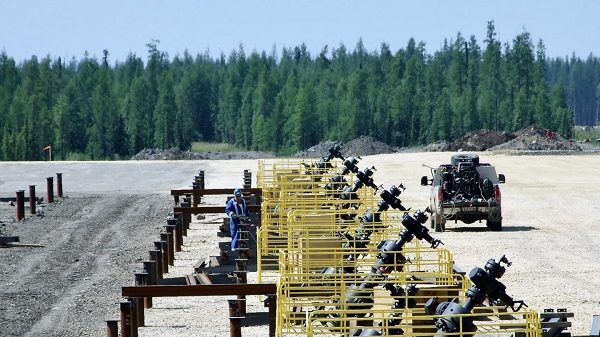Energy
Canadian natural resource minister’s wife invests in oil stocks as gov’t attacks industry

From LifeSiteNews
Records show Tara Wilkinson’s stock purchases include ‘fossil fuel’ producers targeted for eventual elimination by the Liberal government.
The wife of Canadian Natural Resources Minister Jonathan Wilkinson bought oil and gas company stocks, records show, at the same time the federal Liberal government has been attacking the industry in a bid to curb so-called “fossil fuel” use and “fight against climate change.”
According to records as per a recent Blacklock’s Reporter report, Wilkinson’s wife, Tara, amped up her trading in oil and gas stocks last year in Enbridge Incorporated and Shell PLC. The records were found filings under Canada’s Conflict of Interest Code for Members of the House of Commons.
Records show Mrs. Wilkinson also has shares in the globalists linked BlackRock Inc., Amazon, and Finning International Inc., the military-industrial complex linked to Lockheed Martin Corporation, along with COVID jab promoting Pfizer and 3M Company. She also holds stock in Royal Bank and Toronto Dominion Bank.
As early as December, Wilkinson boasted that “Canada became the first oil and gas producer in the world to put a cap on oil and gas emissions.”
He also has claimed that he is looking out for his family’s future by promoting federal climate programs.
Indeed, in 2021, he said he would “honour the commitments we made to our children that we’re going to leave them something that is a workable and sustainable world,” claiming “climate change” is the “existential issue of our time.”
He also claimed, despite his wife and by extension family profiting off oil and gas companies, that “we are on a trajectory to reducing to net zero by 2050” and that “it is important in our fight against climate change.”
Other current and former Liberal cabinet ministers also have oil and gas stocks, such as former Addictions Minister Carolyn Bennett, former Attorney General David Lametti and current Veterans Affairs Minister Ginette Petitpas Taylor.
Oil and gas companies have been racking in high profits due to both a high demand for oil and gas and higher oil prices.
The federal government under Prime Minister Justin Trudeau since 2015 has pushed a radical environmental agenda similar to the agendas being pushed the World Economic Forum’s “Great Reset” and the United Nations “Sustainable Development Goals.”
Late last year, the Trudeau government forged ahead with many policies that if they come to full fruition will destroy Canada’s oil and gas industry, which provides jobs to thousands and is important in Alberta and Saskatchewan.
At COP28 held late last year, Environment Minister Steven Guilbeault unveiled a plan to slash oil and gas emissions by 35% to 38% below 2019 levels. He claimed that it is important to reach “carbon neutrality in Canada by 2050.”
At COP28, he announced a new Liberal federal government climate policy that aims to incentivize beef cattle ranchers to reduce how much gas their cows emit by giving them feed additives.
A recent near power blackout in Alberta due to the failure of wind and solar power, however, highlights how so-called sustainable wind and solar power, which the Trudeau government heavily promotes, are not a good fit for Canada’s cold climate.
Alberta Premier Danielle Smith has blasted Guilbeault as a “menace” for going after her province and the oil and gas industry in general and vowed to fight him with every tool available to her government.
The Trudeau government has also pledged to mandate that all new cars and trucks by 2035 be electric, which would in effect ban the sale of new gasoline- or diesel-only powered vehicles after that year.
The reduction and eventual elimination of the use of so-called “fossil fuels” and a transition to unreliable “green” energy has also been pushed by the World Economic Forum (WEF) – the globalist group behind the socialist “Great Reset” agenda – an organization in which Trudeau and some of his cabinet are involved.
A June 2017 peer-reviewed study by two scientists and a veteran statistician confirmed that most of the recent global warming data have been “fabricated by climate scientists to make it look more frightening.”
There have been two recent court rulings that have dealt a blow to Trudeau’s environmental laws, however.
The most recent was the Federal Court of Canada on November 16 overturned the Trudeau government’s ban on single-use plastic, calling it “unreasonable and unconstitutional.”
The second ruling comes after Canada’s Supreme Court recently sided in favor of provincial autonomy when it comes to natural resources. The Supreme Court recently ruled that Trudeau’s law, C-69, dubbed the “no-more pipelines” bill, is “mostly unconstitutional.” This was a huge win for Alberta and Saskatchewan, which challenged the law in court. The decision returned authority over the pipelines to provincial governments, meaning oil and gas projects headed up by the provinces should be allowed to proceed without federal intrusion.
The Trudeau government, however, seems insistent on defying the recent rulings by pushing forward with its various regulations.
Economy
Top Scientists Deliberately Misrepresented Sea Level Rise For Years

From Michael Shellenberger
Accelerated sea level is one of the main justifications for predicting very high costs for adapting to climate change. And while good scientists have debunked acceleration claims in the past, they did not clearly show how IPCC scientists engaged in their manipulations.
Scientists for years said they had proof that climate change was accelerating sea level rise. But that's not what the evidence shows. They knew the truth and misled the public. And now I have a long email exchange with a top scientist that shows how they did it. Massive scandal. pic.twitter.com/MNIX1025Fe
— Michael Shellenberger (@shellenberger) October 24, 2025
Alberta
B.C. would benefit from new pipeline but bad policy stands in the way

From the Fraser Institute
By Julio Mejía and Elmira Aliakbari
Bill C-69 (a.k.a. the “no pipelines act”) has added massive uncertainty to the project approval process, requiring proponents to meet vague criteria that go far beyond any sensible environmental concerns—for example, assessing any project’s impact on the “intersection of sex and gender with other identity factors.”
In case you haven’t heard, the Alberta government plans to submit a proposal to the federal government to build an oil pipeline from Alberta to British Columbia’s north coast.
But B.C. Premier Eby dismissed the idea, calling it a project imported from U.S. politics and pursued “at the expense of British Columbia and Canada’s economy.” He’s simply wrong. A new pipeline wouldn’t come at the expense of B.C. or Canada’s economy—it would strengthen both. In fact, particularly during the age of Trump, provinces should seek greater cooperation and avoid erecting policy barriers that discourage private investment and restrict trade and market access.
The United States remains the main destination for Canada’s leading exports, oil and natural gas. In 2024, nearly 96 per cent of oil exports and virtually all natural gas exports went to our southern neighbour. In light of President Trump’s tariffs on Canadian energy and other goods, it’s long past time to diversify our trade and find new export markets.
Given that most of Canada’s oil and gas is landlocked in the Prairies, pipelines to coastal terminals are the only realistic way to reach overseas markets. After the completion of the Trans Mountain Pipeline Expansion (TMX) project in May 2024, which transports crude oil from Alberta to B.C. and opened access to Asian markets, exports to non-U.S. destinations increased by almost 60 per cent. This new global reach strengthens Canada’s leverage in trade negotiations with Washington, as it enables Canada to sell its energy to markets beyond the U.S.
Yet trade is just one piece of the broader economic impact. In its first year of operation, the TMX expansion generated $13.6 billion in additional revenue for the economy, including $2.0 billion in extra tax revenues for the federal government. By 2043, TMX operations will contribute a projected $9.2 billion to Canada’s economic output, $3.7 billion in wages, and support the equivalent of more than 36,000 fulltime jobs. And B.C. stands to gain the most, with $4.3 billion added to its economic output, nearly $1 billion in wages, and close to 9,000 new jobs. With all due respect to Premier Eby, this is good news for B.C. workers and the provincial economy.
In contrast, cancelling pipelines has come at a real cost to B.C. and Canada’s economy. When the Trudeau government scrapped the already-approved Northern Gateway project, Canada lost an opportunity to increase the volume of oil transported from Alberta to B.C. and diversify its trading partners. Meanwhile, according to the Canadian Energy Centre, B.C. lost out on nearly 8,000 jobs a year (or 224,344 jobs in 29 years) and more than $11 billion in provincial revenues from 2019 to 2048 (inflation-adjusted).
Now, with the TMX set to reach full capacity by 2027/28, and Premier Eby opposing Alberta’s pipeline proposal, Canada may miss its chance to export more to global markets amid rising oil demand. And Canadians recognize this opportunity—a recent poll shows that a majority of Canadians (including 56 per cent of British Columbians) support a new oil pipeline from Alberta to B.C.
But, as others have asked, if the economic case is so strong, why has no private company stepped up to build or finance a new pipeline?
Two words—bad policy.
At the federal level, Bill C-48 effectively bans large oil tankers from loading or unloading at ports along B.C.’s northern coast, undermining the case for any new private-sector pipeline. Meanwhile, Bill C-69 (a.k.a. the “no pipelines act”) has added massive uncertainty to the project approval process, requiring proponents to meet vague criteria that go far beyond any sensible environmental concerns—for example, assessing any project’s impact on the “intersection of sex and gender with other identity factors.” And the federal cap on greenhouse gas (GHG) emissions exclusively for the oil and gas sector will inevitably force a reduction in oil and gas production, again making energy projects including pipelines less attractive to investors.
Clearly, policymakers in Canada should help diversify trade, boost economic growth and promote widespread prosperity in B.C., Alberta and beyond. To achieve this goal, they should put politics aside, focus of the benefits to their constituents, and craft regulations that more thoughtfully balance environmental concerns with the need for investment and economic growth.
-

 Alberta11 hours ago
Alberta11 hours agoBusting five myths about the Alberta oil sands
-

 Business15 hours ago
Business15 hours agoQuebecers want feds to focus on illegal gun smuggling not gun confiscation
-

 Health14 hours ago
Health14 hours agoNew report warns WHO health rules erode Canada’s democracy and Charter rights
-

 Energy13 hours ago
Energy13 hours agoMinus Forty and the Myth of Easy Energy
-

 Fraser Institute12 hours ago
Fraser Institute12 hours agoMétis will now get piece of ever-expanding payout pie
-

 Business2 days ago
Business2 days agoLiberals backtrack on bill banning large cash gifts, allowing police to search Canadians’ mail
-

 DEI2 days ago
DEI2 days agoConservative push to end Canada’s ‘anti-merit’ DEI programs receives support
-

 Alberta2 days ago
Alberta2 days agoPremier Smith moves to protect Alberta in International Agreements







